lock Lancia Delta 2011 Owner handbook (in English)
[x] Cancel search | Manufacturer: LANCIA, Model Year: 2011, Model line: Delta, Model: Lancia Delta 2011Pages: 290, PDF Size: 8.36 MB
Page 116 of 290
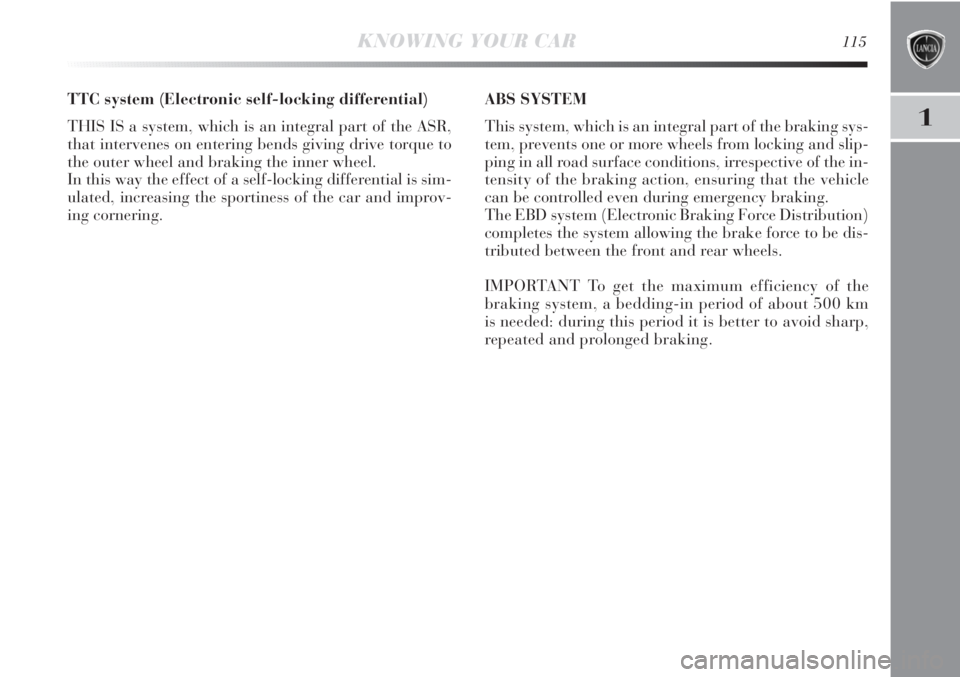
1
KNOWING YOUR CAR115
TTC system (Electronic self-locking differential)
THIS IS a system, which is an integral part of the ASR,
that intervenes on entering bends giving drive torque to
the outer wheel and braking the inner wheel.
In this way the effect of a self-locking differential is sim-
ulated, increasing the sportiness of the car and improv-
ing cornering.ABS SYSTEM
This system, which is an integral part of the braking sys-
tem, prevents one or more wheels from locking and slip-
ping in all road surface conditions, irrespective of the in-
tensity of the braking action, ensuring that the vehicle
can be controlled even during emergency braking.
The EBD system (Electronic Braking Force Distribution)
completes the system allowing the brake force to be dis-
tributed between the front and rear wheels.
IMPORTANT To get the maximum efficiency of the
braking system, a bedding-in period of about 500 km
is needed: during this period it is better to avoid sharp,
repeated and prolonged braking.
Page 117 of 290
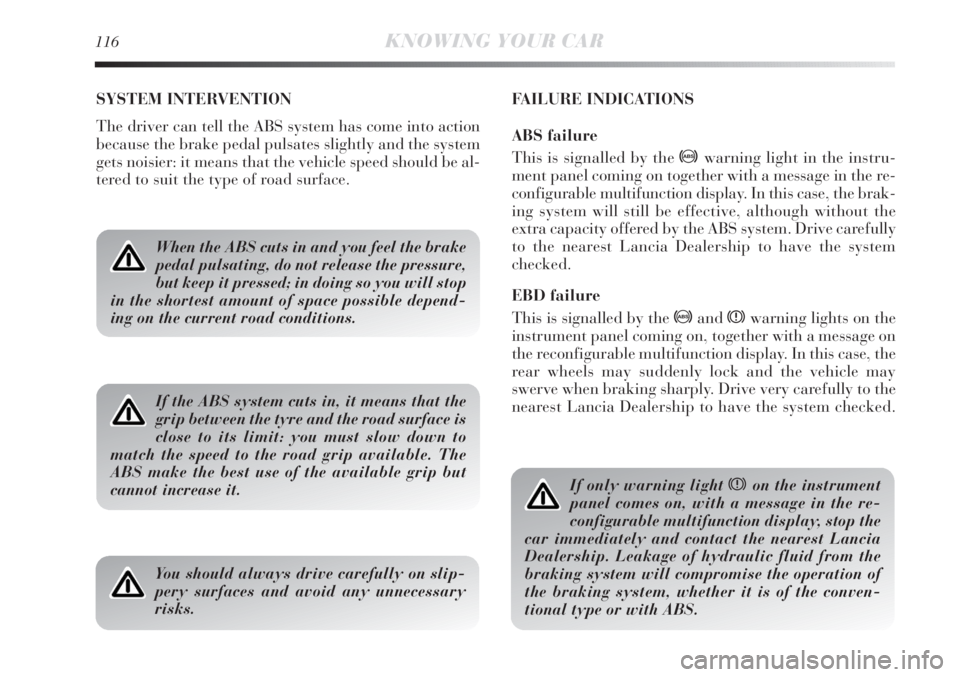
116KNOWING YOUR CAR
SYSTEM INTERVENTION
The driver can tell the ABS system has come into action
because the brake pedal pulsates slightly and the system
gets noisier: it means that the vehicle speed should be al-
tered to suit the type of road surface.FAILURE INDICATIONS
ABS failure
This is signalled by the >warning light in the instru-
ment panel coming on together with a message in the re-
configurable multifunction display. In this case, the brak-
ing system will still be effective, although without the
extra capacity offered by the ABS system. Drive carefully
to the nearest Lancia Dealership to have the system
checked.
EBD failure
This is signalled by the >andxwarning lights on the
instrument panel coming on, together with a message on
the reconfigurable multifunction display. In this case, the
rear wheels may suddenly lock and the vehicle may
swerve when braking sharply. Drive very carefully to the
nearest Lancia Dealership to have the system checked.
When the ABS cuts in and you feel the brake
pedal pulsating, do not release the pressure,
but keep it pressed; in doing so you will stop
in the shortest amount of space possible depend-
ing on the current road conditions.
If the ABS system cuts in, it means that the
grip between the tyre and the road surface is
close to its limit: you must slow down to
match the speed to the road grip available. The
ABS make the best use of the available grip but
cannot increase it.
You should always drive carefully on slip-
pery surfaces and avoid any unnecessary
risks.
If only warning light xon the instrument
panel comes on, with a message in the re-
configurable multifunction display, stop the
car immediately and contact the nearest Lancia
Dealership. Leakage of hydraulic fluid from the
braking system will compromise the operation of
the braking system, whether it is of the conven-
tional type or with ABS.
Page 125 of 290
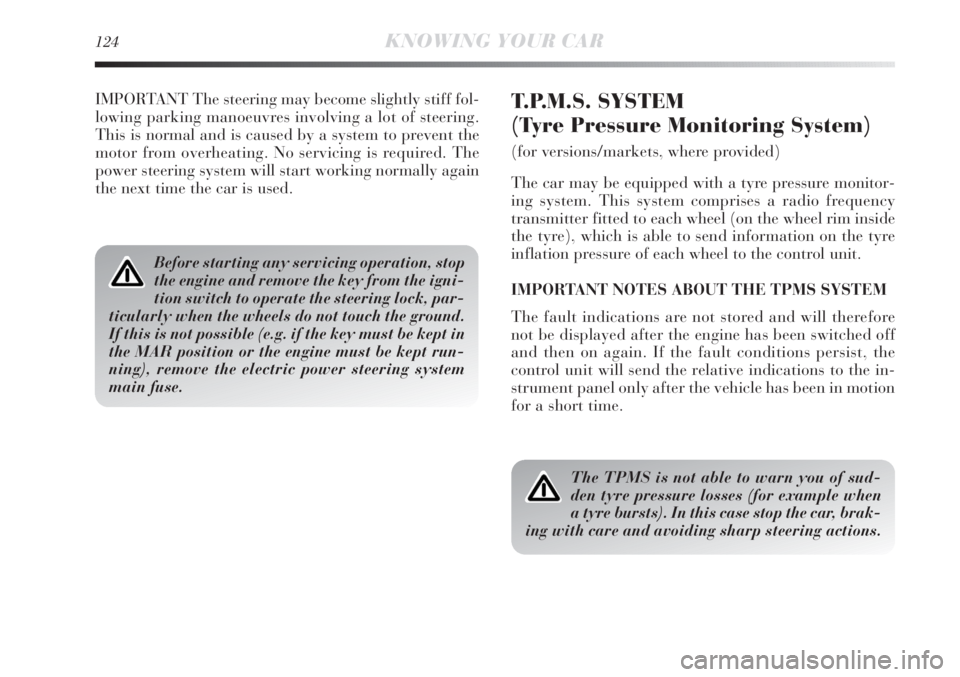
124KNOWING YOUR CAR
IMPORTANT The steering may become slightly stiff fol-
lowing parking manoeuvres involving a lot of steering.
This is normal and is caused by a system to prevent the
motor from overheating. No servicing is required. The
power steering system will start working normally again
the next time the car is used.T.P.M.S. SYSTEM
(Tyre Pressure Monitoring System)
(for versions/markets, where provided)
The car may be equipped with a tyre pressure monitor-
ing system. This system comprises a radio frequency
transmitter fitted to each wheel (on the wheel rim inside
the tyre), which is able to send information on the tyre
inflation pressure of each wheel to the control unit.
IMPORTANT NOTES ABOUT THE TPMS SYSTEM
The fault indications are not stored and will therefore
not be displayed after the engine has been switched off
and then on again. If the fault conditions persist, the
control unit will send the relative indications to the in-
strument panel only after the vehicle has been in motion
for a short time.
Before starting any servicing operation, stop
the engine and remove the key from the igni-
tion switch to operate the steering lock, par-
ticularly when the wheels do not touch the ground.
If this is not possible (e.g. if the key must be kept in
the MAR position or the engine must be kept run-
ning), remove the electric power steering system
main fuse.
The TPMS is not able to warn you of sud-
den tyre pressure losses (for example when
a tyre bursts). In this case stop the car, brak-
ing with care and avoiding sharp steering actions.
Page 148 of 290
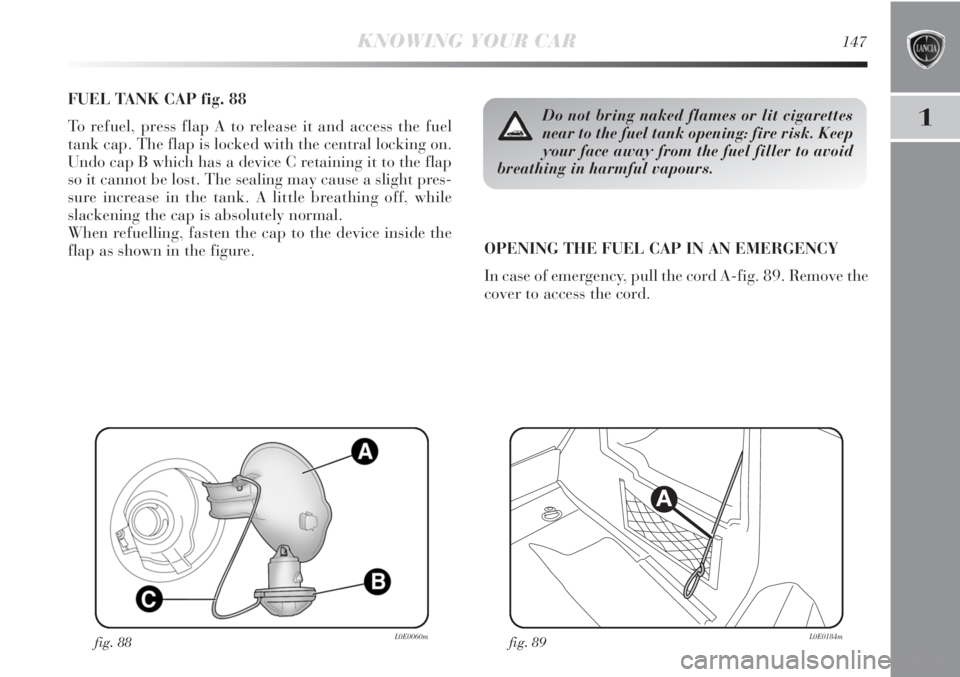
1
KNOWING YOUR CAR147
FUEL TANK CAP fig. 88
To refuel, press flap A to release it and access the fuel
tank cap. The flap is locked with the central locking on.
Undo cap B which has a device C retaining it to the flap
so it cannot be lost. The sealing may cause a slight pres-
sure increase in the tank. A little breathing off, while
slackening the cap is absolutely normal.
When refuelling, fasten the cap to the device inside the
flap as shown in the figure.OPENING THE FUEL CAP IN AN EMERGENCY
In case of emergency, pull the cord A-fig. 89. Remove the
cover to access the cord.
fig. 88L0E0060mfig. 89L0E0184m
A
Do not bring naked flames or lit cigarettes
near to the fuel tank opening: fire risk. Keep
your face away from the fuel filler to avoid
breathing in harmful vapours.
Page 151 of 290
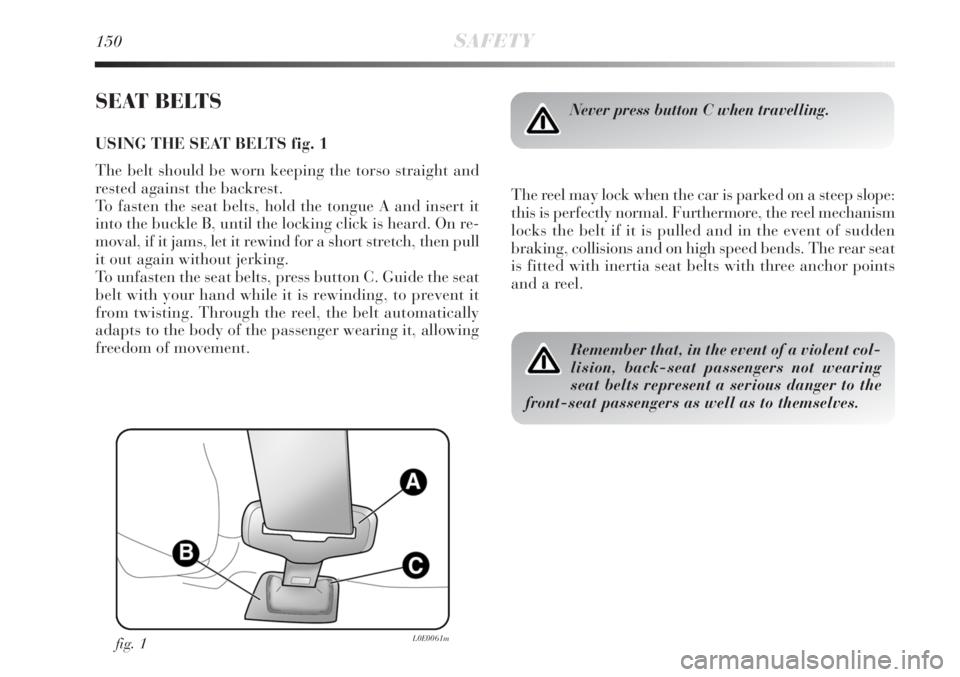
150SAFETY
SEAT BELTS
USING THE SEAT BELTS fig. 1
The belt should be worn keeping the torso straight and
rested against the backrest.
To fasten the seat belts, hold the tongue A and insert it
into the buckle B, until the locking click is heard. On re-
moval, if it jams, let it rewind for a short stretch, then pull
it out again without jerking.
To unfasten the seat belts, press button C. Guide the seat
belt with your hand while it is rewinding, to prevent it
from twisting. Through the reel, the belt automatically
adapts to the body of the passenger wearing it, allowing
freedom of movement.The reel may lock when the car is parked on a steep slope:
this is perfectly normal. Furthermore, the reel mechanism
locks the belt if it is pulled and in the event of sudden
braking, collisions and on high speed bends. The rear seat
is fitted with inertia seat belts with three anchor points
and a reel.
Never press button C when travelling.
Remember that, in the event of a violent col-
lision, back-seat passengers not wearing
seat belts represent a serious danger to the
front-seat passengers as well as to themselves.
fig. 1L0E0061m
Page 152 of 290

2
SAFETY151
The rear seat belts must be used as shown in the diagram
in fig. 2.
IMPORTANT After putting the seats back to their trav-
elling position, restore the seat belt position to make them
ready for use.
IMPORTANT If the rear seat is being moved and this
causes the middle seat belt to lock temporarily, normal
conditions can be restored by simply moving the seat to-
wards the back of the car.
fig. 2L0E0062m
S.B.R. SYSTEM
The car is provided with the S.B.R. (Seat Belt Reminder)
system, which warns the driver and the front passenger
if the seat belt is not fastened, as follows:
❍warning light
❍warning light
For permanent deactivation, contact a Lancia Dealer-
ship.
S.B.R. system can also be reactivated through the set-up
menu.
Page 153 of 290
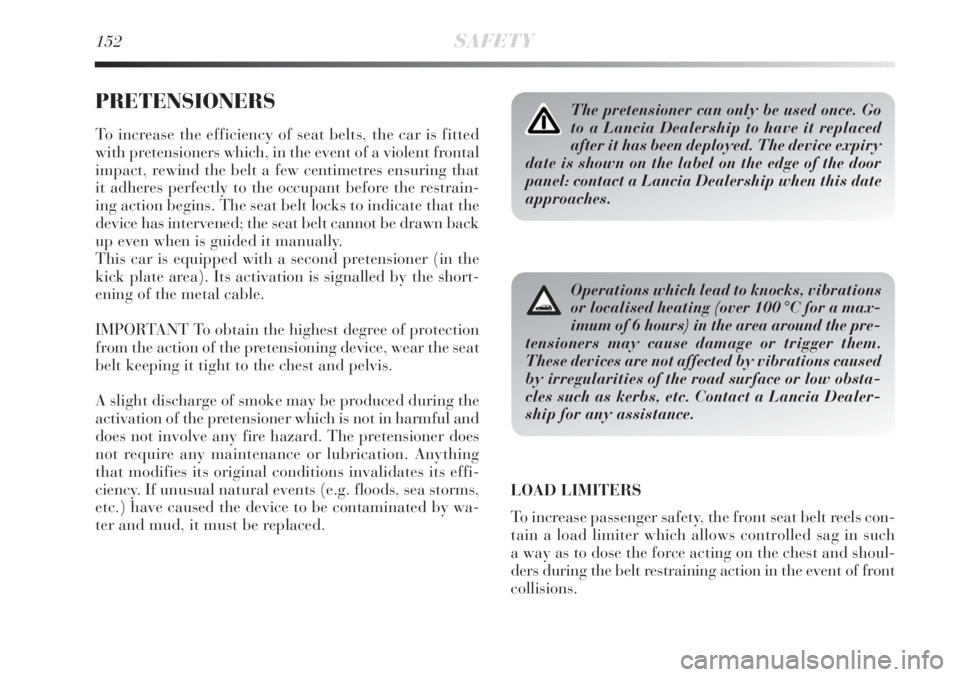
152SAFETY
PRETENSIONERS
To increase the efficiency of seat belts, the car is fitted
with pretensioners which, in the event of a violent frontal
impact, rewind the belt a few centimetres ensuring that
it adheres perfectly to the occupant before the restrain-
ing action begins. The seat belt locks to indicate that the
device has intervened; the seat belt cannot be drawn back
up even when is guided it manually.
This car is equipped with a second pretensioner (in the
kick plate area). Its activation is signalled by the short-
ening of the metal cable.
IMPORTANT To obtain the highest degree of protection
from the action of the pretensioning device, wear the seat
belt keeping it tight to the chest and pelvis.
A slight discharge of smoke may be produced during the
activation of the pretensioner which is not in harmful and
does not involve any fire hazard. The pretensioner does
not require any maintenance or lubrication. Anything
that modifies its original conditions invalidates its effi-
ciency. If unusual natural events (e.g. floods, sea storms,
etc.) have caused the device to be contaminated by wa-
ter and mud, it must be replaced.
The pretensioner can only be used once. Go
to a Lancia Dealership to have it replaced
after it has been deployed. The device expiry
date is shown on the label on the edge of the door
panel: contact a Lancia Dealership when this date
approaches.
Operations which lead to knocks, vibrations
or localised heating (over 100 °C for a max-
imum of 6 hours) in the area around the pre-
tensioners may cause damage or trigger them.
These devices are not affected by vibrations caused
by irregularities of the road surface or low obsta-
cles such as kerbs, etc. Contact a Lancia Dealer-
ship for any assistance.
LOAD LIMITERS
To increase passenger safety, the front seat belt reels con-
tain a load limiter which allows controlled sag in such
a way as to dose the force acting on the chest and shoul-
ders during the belt restraining action in the event of front
collisions.
Page 173 of 290
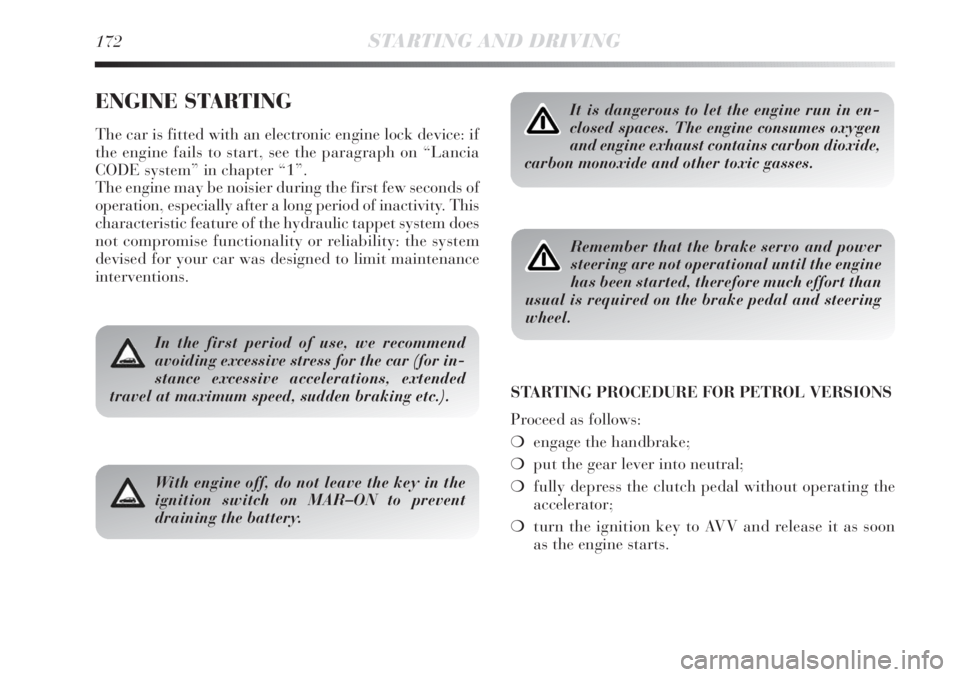
172STARTING AND DRIVING
ENGINE STARTING
The car is fitted with an electronic engine lock device: if
the engine fails to start, see the paragraph on “Lancia
CODE system” in chapter “1”.
The engine may be noisier during the first few seconds of
operation, especially after a long period of inactivity. This
characteristic feature of the hydraulic tappet system does
not compromise functionality or reliability: the system
devised for your car was designed to limit maintenance
interventions.
In the first period of use, we recommend
avoiding excessive stress for the car (for in-
stance excessive accelerations, extended
travel at maximum speed, sudden braking etc.).
With engine off, do not leave the key in the
ignition switch on MAR–ON to prevent
draining the battery.
It is dangerous to let the engine run in en-
closed spaces. The engine consumes oxygen
and engine exhaust contains carbon dioxide,
carbon monoxide and other toxic gasses.
Remember that the brake servo and power
steering are not operational until the engine
has been started, therefore much effort than
usual is required on the brake pedal and steering
wheel.
STARTING PROCEDURE FOR PETROL VERSIONS
Proceed as follows:
❍engage the handbrake;
❍put the gear lever into neutral;
❍fully depress the clutch pedal without operating the
accelerator;
❍turn the ignition key to AVV and release it as soon
as the engine starts.
Page 176 of 290

3
STARTING AND DRIVING175
HANDBRAKE
The handbrake lever is located between the two front
seats.
Pull the lever upwards to operate the handbrake, until
the vehicle is braked.
The car should be braked after a few clicks
of the lever; if it is not, contact a Lancia
Dealership to have it adjusted.
When the handbrake is on and the ignition key is at MAR,
the instrument panel warning light xwill come on.
Proceed as follows to release the handbrake:
❍slightly lift the handbrake and press release button
A-fig. 1;
❍keep button A pressed and lower the lever. The warn-
ing light xon the instrument panel will turn off.
Press the brake pedal when carrying out this operation
to prevent the car from moving accidentally. PARKING THE VEHICLE
Proceed as follows:
❍stop the engine and engage the handbrake;
❍engage a gear (on a slope, engage first gear if the car
is facing uphill or reverse if it is facing downhill) and
leave the wheels steered.
If the car is parked on a steep slope, it is also advisable
to block the wheels with a wedge or stone.
Do not leave the ignition key turned to MAR to prevent
draining the battery. Always remove the key when you
leave the car.
Never leave children in the unattended car. Always re-
move the ignition key when leaving the car and take it
out with you.
fig. 1L0E0072m
Page 193 of 290

192IN AN EMERGENCY
CYLINDER REPLACEMENT PROCEDURE
To replace the cylinder, proceed as follows:
❍disconnect connection A-fig. 7;
❍turn the cylinder to be replaced anticlockwise and
raise it;
❍fit the new cylinder and turn it clockwise;
❍connect connection A to the cylinder and fit the trans-
parent tube B in the dedicated space.
fig. 7L0E0080m